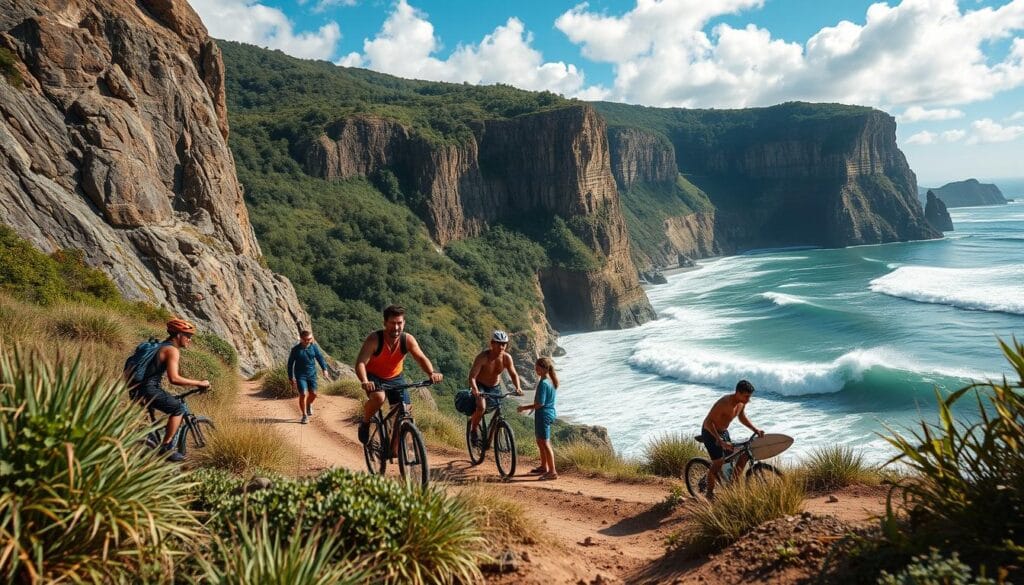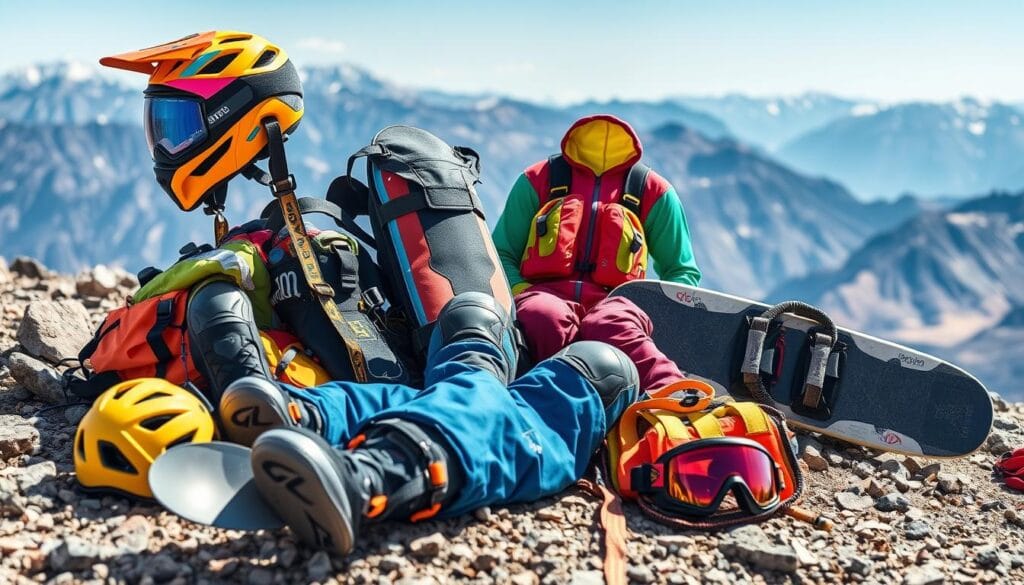Extreme Sports Advice, As a thrill-seeker, I’ve always been drawn to the rush of extreme sports. Activities like climbing high walls or flying through the air change our lives. But, we must remember to stay safe, learn the right skills, and handle the risks.
This guide is your compass for extreme sports. It covers everything from starting to advanced techniques. Whether you’re experienced or new, you’ll find the advice and strategies here to face challenges with confidence.
Table of Contents

Key Takeaways
- Discover the importance of assessing your physical fitness level before starting extreme sports.
- Learn how to choose the right extreme sport for your skill level and interests.
- Understand the critical role of finding qualified instructors to guide your journey.
- Explore the essential safety gear and equipment investments to protect yourself.
- Discover strategies for managing weather conditions, emergency response, and legal considerations.
- Recognize the value of mental preparation and psychological training for extreme sports.
- Gain the knowledge and confidence to pursue your thrill-seeking dreams safely and responsibly.
Getting Started with Extreme Sports: Your Beginner’s Guide
Ready to dive into the world of extreme sports? Whether you love adventure training or just want to feel the rush, starting can seem tough. But don’t worry, our guide will help you start your thrill-seeking journey with ease.
Assessing Your Physical Fitness Level
Before you jump into extreme sports, check your physical fitness. Look at your strength, flexibility, and endurance. Make sure you’re ready for the sport you choose. Talk to a fitness expert or doctor to create a training plan that gets you ready.
Choosing Your First Extreme Sport
- Think about what you like and what makes you comfortable. Do you want to fly high or splash in the water?
- Look into different sports like skydiving, rock climbing, or rafting. Pick the one that fits your adventurous side.
- Start with something safe, like indoor climbing or beginner surfing lessons.
Finding Qualified Instructors
Getting good instruction is key when starting extreme sports. Look for certified coaches who teach the basics, safety, and how to improve. Choose schools, clubs, or groups that focus on safety and offer full training.
“The first step towards getting somewhere is to decide that you are not going to stay where you are.” – J.P. Morgan
Starting your journey to becoming a thrill-seeker is all about a strong base. By checking your fitness, picking the right sport, and finding great instructors, you’re set for an exciting adventure. Get ready to explore and enjoy the thrill!

Essential Safety Gear and Equipment Investment
Getting the right safety gear is key for extreme sports and unconventional sports. The right equipment can lower injury risks and make your experience better. Whether you’re a pro or new to thrill-seeking, safety should always be your top concern.
For safety gear, choose quality over anything else. Go for durable, well-made, and certified gear made for your sport. This could be helmets, pads, harnesses, and special clothes.
Here are some tips to get you ready:
- Do your homework on the gear you need for your unconventional sport.
- Buy top-notch gear from trusted brands.
- Check and keep your gear in top shape.
- Swap out any worn or broken gear to keep your safety gear up to par.
By focusing on safety gear and investing in good equipment, you can dive into extreme sports with confidence. You’ll know you’re ready for whatever comes your way.
| Essential Gear for Extreme Sports | Recommended Features |
|---|---|
| Helmet | Impact-resistant, well-ventilated, certified for the specific sport |
| Protective Pads | Padded coverage for elbows, knees, and other vulnerable areas |
| Harness | Adjustable, secure, and compatible with the sport’s equipment |
| Specialized Clothing | Moisture-wicking, breathable, and designed for the activity |
Remember, the right safety gear is crucial for enjoying extreme fitness safely and with confidence.

“The right gear can be the difference between a thrilling experience and a trip to the hospital. Prioritize safety and you’ll be able to focus on the excitement of the moment.”
Extreme Sports Advice: Risk Management and Safety Protocols
Going on extreme sports adventures is more than just being physically strong. It’s also about managing risks and following safety rules. This way, you can have fun while staying safe. Let’s look at how to manage risks and stay safe while enjoying your thrill-seeking activities.
Understanding Weather Conditions
It’s key for extreme sports fans to watch the weather closely. Wind, rain, temperature, and how clear it is can change your safety and how fun it is. Always check the latest weather forecast before you go and be ready to change your plans if needed.
Emergency Response Planning
Even with good planning, emergencies can still happen. Make a detailed plan for what to do in an emergency. This plan should include where to find medical help, how to stay in touch, and having the right safety gear and first-aid supplies.
Insurance and Legal Considerations
Extreme sports come with risks, and you need to protect yourself. Look into getting insurance that covers adventure sports or personal liability. Also, learn about the laws and rules of the sport or place you’re going to. This helps you stay legal and safe.
“Preparation is the key to unlocking the true thrill of extreme sports. With the right risk management strategies and safety protocols in place, you can push your boundaries while prioritizing your well-being.” – Extreme Sports Enthusiast
By following these important safety and risk management tips, you can start your extreme sports adventures with confidence. You’ll know you’re taking care of yourself and ready to enjoy your activities to the fullest.
Mental Preparation and Psychological Training
Extreme sports need more than just physical strength. You also need a strong mental game. Psychological training helps you reach your full potential and face risks with confidence.
Building a strong mindset is key to extreme fitness. Techniques like visualization and mindfulness help you deal with fear and danger. These skills keep you focused and ready to make quick decisions.
Extreme sports are about more than just physical skills. They require a balance of mind, body, and spirit. By focusing on your mental health, you’ll be ready for the thrill-seeking lifestyle and achieve new heights.
FAQ
What are the essential steps for beginners to get started with extreme sports?
To start with extreme sports, first check your physical fitness. Then, pick a sport that fits you well. Find good instructors to teach you the basics. This will help you enjoy extreme sports safely and have fun.
What types of safety gear and equipment are crucial for extreme sports?
Quality safety gear and equipment are key for extreme sports. You’ll need helmets, pads, harnesses, and specific gear for your sport. The right equipment and regular checks can lower injury risks.
How can I effectively manage risks and stay safe in extreme sports?
Managing risks and staying safe is crucial. Know the weather, have emergency plans, and think about insurance and laws. Being informed and proactive about safety can reduce dangers.
What role does mental preparation play in extreme sports performance and safety?
Mental fitness is as important as physical training. Learning to handle fear and anxiety can improve your performance and safety. Adding mental training to your routine is vital for success in extreme sports.
What are some tips for choosing the right extreme sport to try?
When picking your first extreme sport, think about your fitness, interests, and access to instructors and facilities. Choose a sport that matches your abilities and comfort. This will help you build confidence and have a good time.
